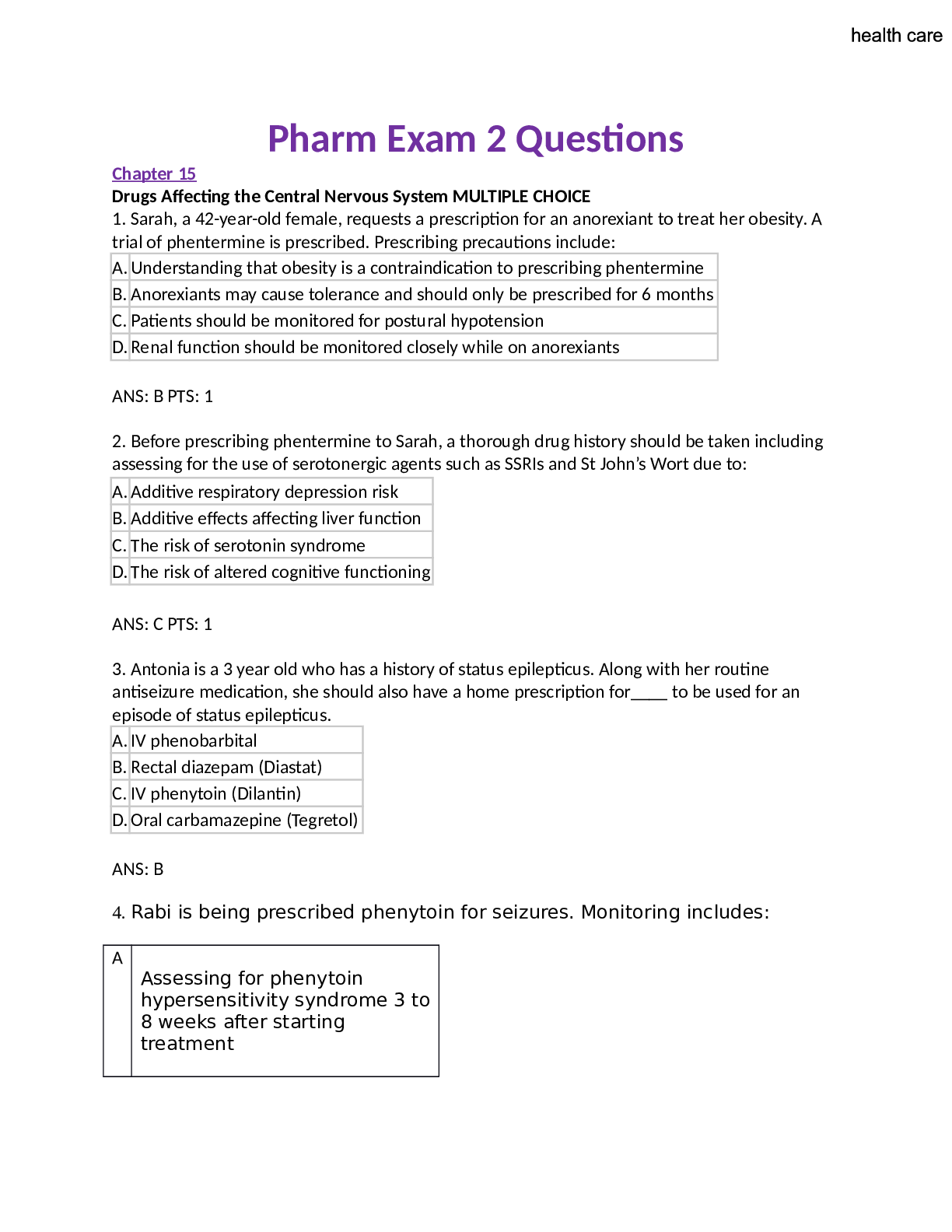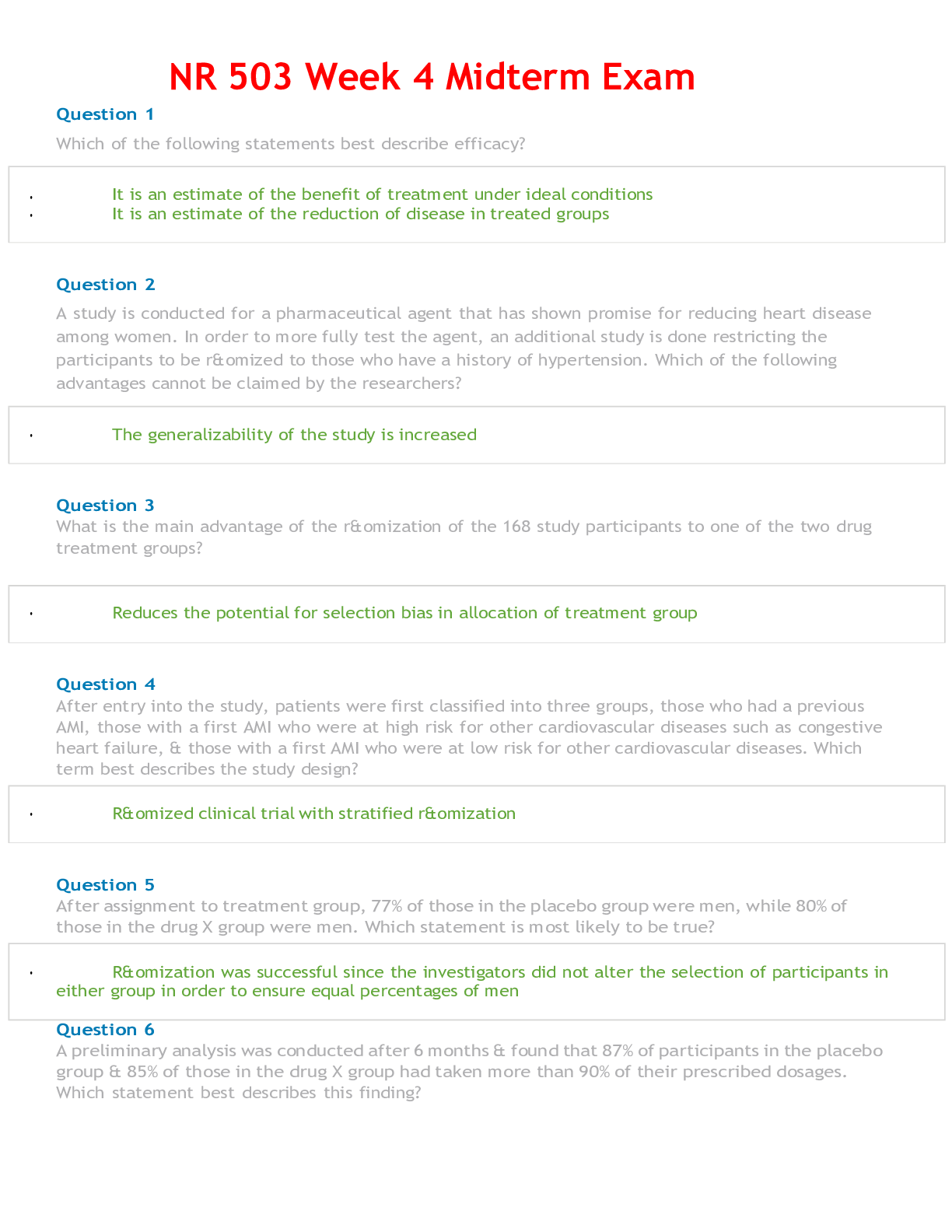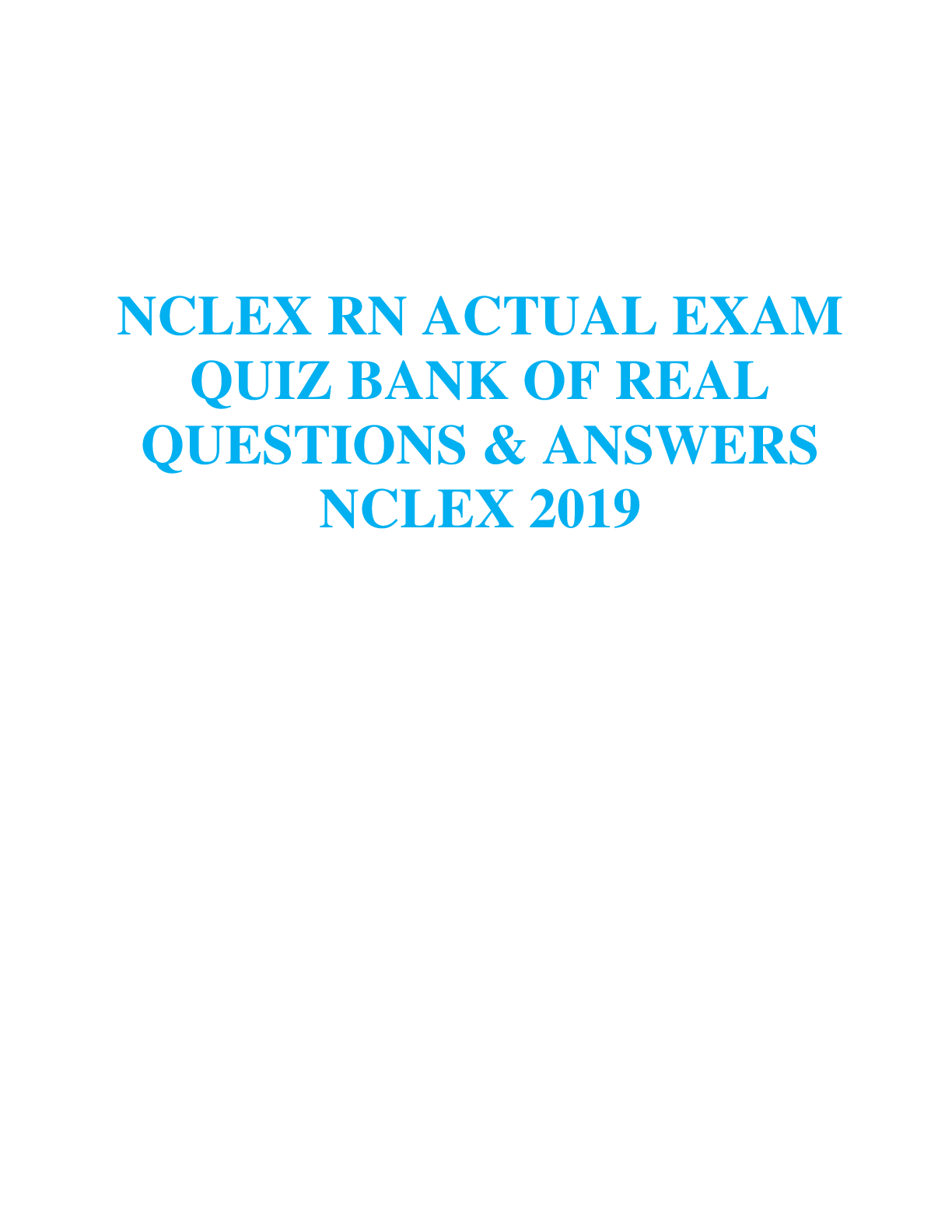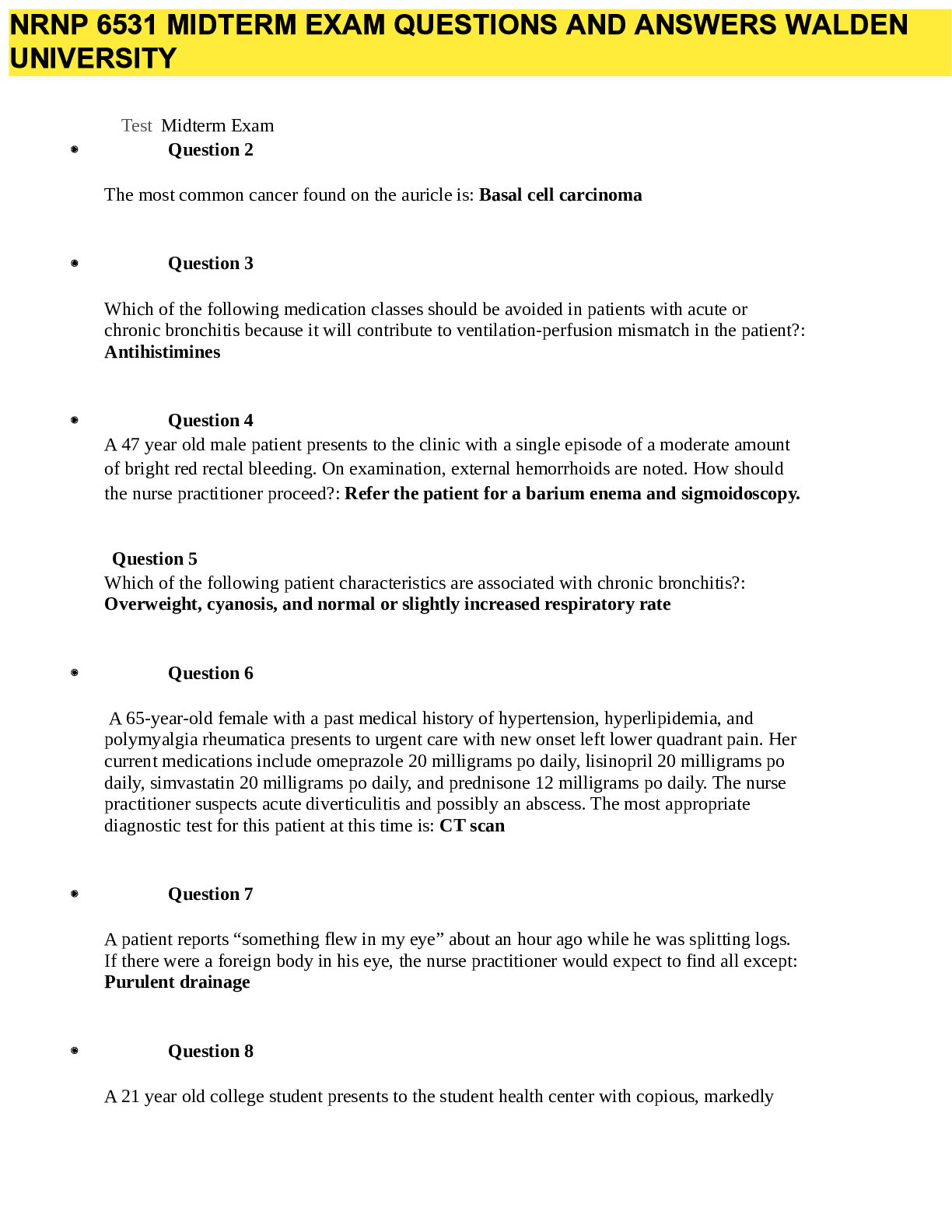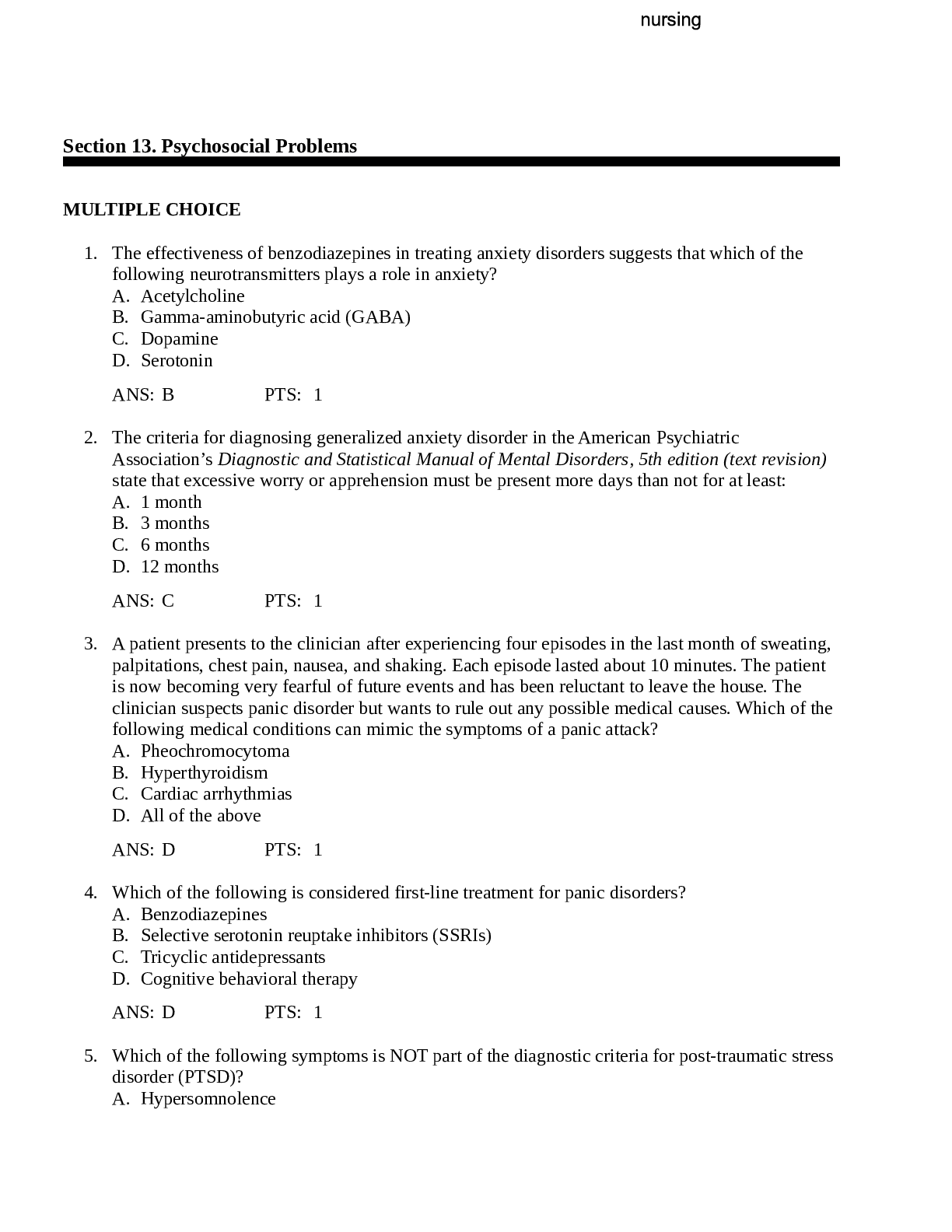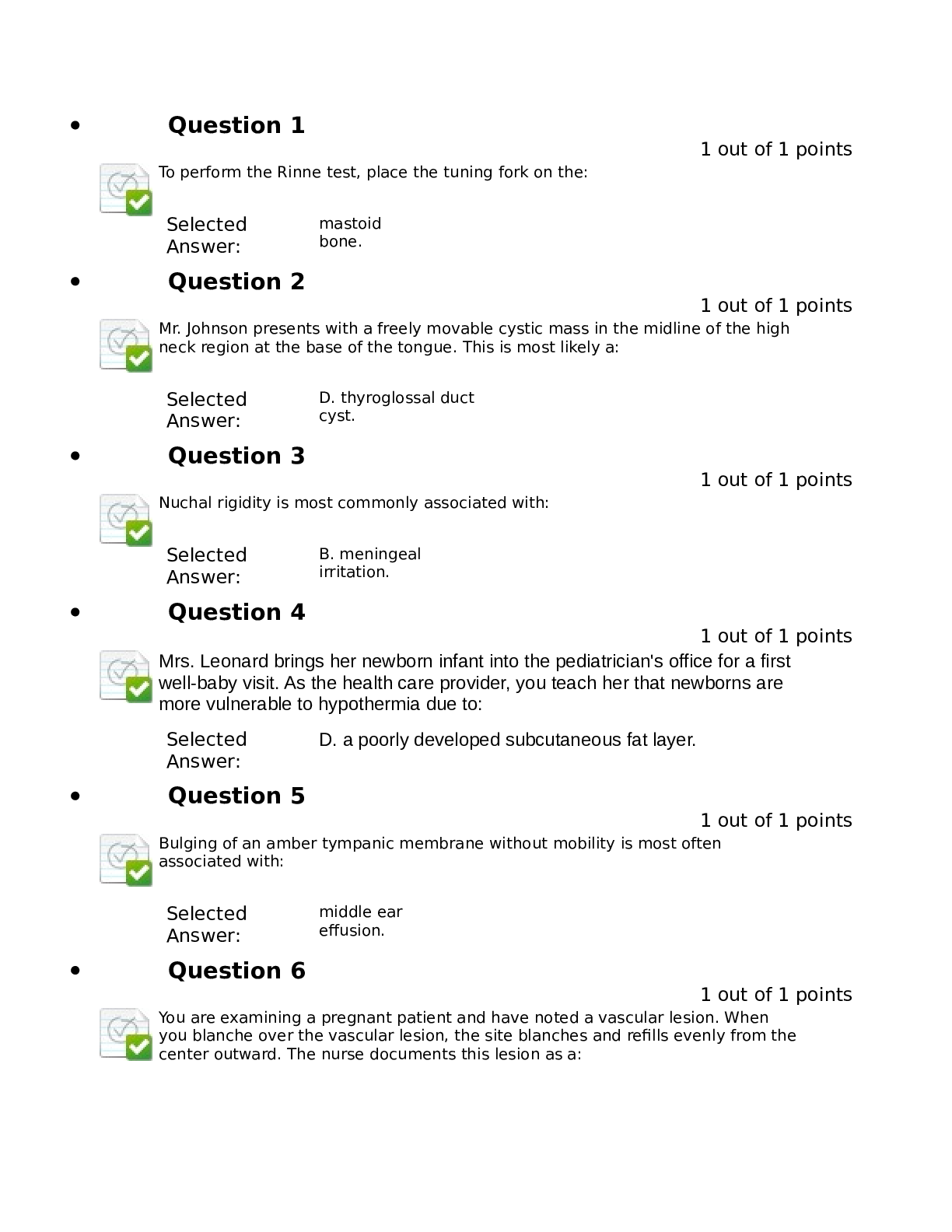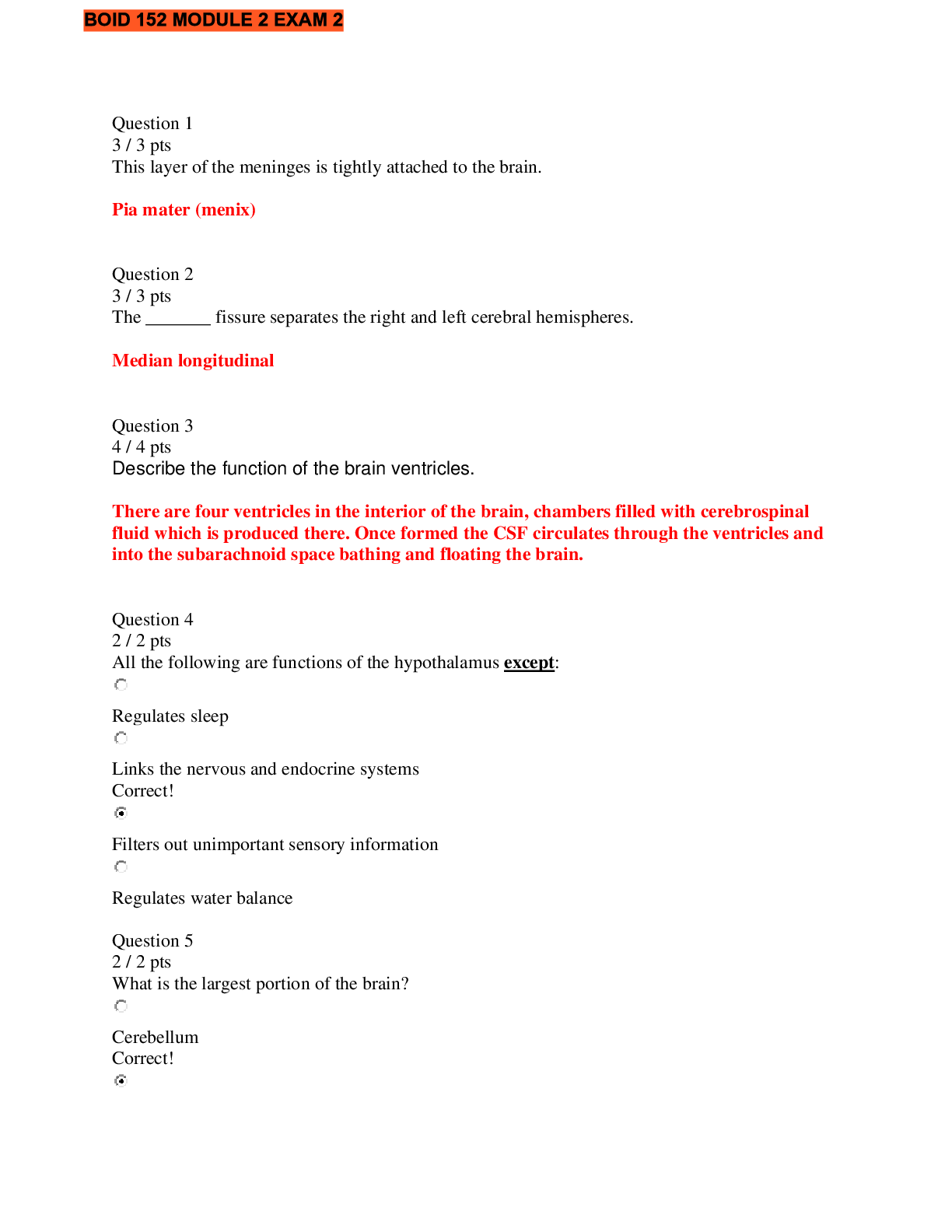Health Care > QUESTIONS & ANSWERS > 2021_MidTerm NRNP6665 health care questions 7 ANSWERS (All)
2021_MidTerm NRNP6665 health care questions 7 ANSWERS
Document Content and Description Below
Question 1 Biofeedback, deep breathing, mindfulness, and progressive muscle relaxation are strategies that are typically used in which of the following therapies? A . Relaxation therapy B . So... cial skills training C . Motivational Interviewing D . Applied behavioral analysis Question 2 According to the APA which of the following are required to support a child’s DSM5 diagnosis? A . The child’s clinical presentation fulfills the specific symptom based diagnostic criteria. B . The child’s symptoms are not caused by other diagnoses or stressors. C . The child’s symptoms are impairing a child’s functioning in at least two settings. D . A and B Question 3 Which of the following is NOT consistent with good sleep hygiene? A . Allow child to keep a cell phone at bedside. B . Establish bedtime routines and maintain consistently. C . Limit use of electronics in the evening i.e., television, computer, etc. D . Set and maintain a bedtime that will allow for adequate sleep. Question 4 Which of the following antipsychotic medications have the greatest tendency to increase appetite and body weight? A . Aripiprazole (Abilify) B . Ziprasidone (Geodon) C . Haloperidol (Haldol) D . Risperidone (Risperdal) Question 5 When assessing a child with disruptive or aggressive behavior, the clinician asks “Have you been thinking about or planning to hurt anyone?” to screen for which of the following diagnostic categories? A . Safety B . Bullying C . Conduct disorder D . Oppositional defiant disorder Question 6 The clinician assessing substance abuse in an adolescent asks, “Did you develop more mood or anxiety problems after you started using?” to screen for which of the following diagnostic possibilities? A . Substance use disorder B . Substance withdrawal C . Substance tolerance D . Substance induced mental disorder Question 7 When the patient lacks capacity to make a decision the nurse has the ethical responsibility to do which of the following? A . Become a surrogate decision maker for the patient. B Consult a formally-designated surrogate for patient choices. . C . Make safe choices for the patient based on the nurse’s beliefs and values. D . Continue to support all the patient’s choices until a surrogate can be found. Question 8 When assessing a child who has presented with concerns of being anxious and worried, the provider asks the child “Do you get sudden surges of fear that make your body feel shaky or your heart race?” to screen for which of the following common diagnostic possibilities? A . Obsessive -compulsive disorder B . Posttraumatic stress disorder C . Panic disorder D . Separation anxiety disorder Question 9 Which of the following antipsychotic medications has the greatest risk for weight gain and lipid changes? A . Ziprasidone (Geodon) B . Aripiprazole (Abilify) C . Olanzapine (Zyprexa) D . Quetiapine (Seroquel) Question 10 A period of at least one week in which both a manic episode and a major depressive episode occur almost daily is consistent with which diagnosis? A . Bipolar II Disorder B . Cyclothymic Disorder C . Bipolar I Disorder, mixed episode D . Bipolar I Disorder, cyclothymic type Question 11 Which of the following is NOT true about symptomatology of anorexia nervosa? A . Most aberrant behaviors directed toward losing weight occurs in secret. B . All patients have an intense fear of gaining weight and becoming obese. C . Most patients with anorexia nervosa will have no difficulty eating with their family in public places. D . Fear of gaining weight and becoming obese frequently contributes to the individual’s lack of interest in and resistance to therapy/treatment. Question 12 Sleep-related hallucinations occurring at sleep onset are known as which of the following? A . Hypnagogic B . Hypnopompic C . Complex hallucinations D . Paranormal hallucinations Question 13 The theory that depression results from specific thought distortions is consistent with which of the following? A . Cognitive theory B . Psychosocial theory C . Psychodynamic theory D . Learned helplessness theory Question 14 Reasons for the underuse of specific mental health treatments during childhood include which of the following? A . Stigma associated with mental health B . Poor problem recognition C . Limited availability of mental health specialists D . All of the above Question 15 Which of the following is true regarding the cultural formulation interview with a child and caregiver? A . Asking about a child and caregiver’s cultural understanding is an efficient way to build a therapeutic alliance. B . While cultural understanding is important, it is important not to personalize the diagnosis. C . While obtaining cultural information is important, it may increase bias and thus decrease accuracy of the assessment. D . Engaging in a discussion about culture, while interesting and engaging, is a distraction from the problem that brought the child and caregiver to the provider. Question 16 According to the APA, “Psychologists seek to promote accuracy, honesty, and truthfulness in the practice of psychology,” reflecting which of the following ethical principles? A . Integrity B . Justice C . Beneficence D . Nonmalefice nce Question 17 Which of the following antidepressant medications have the greatest tendency to increase appetite and body weight? A . Fluoxetine (Prozac) B . Trazodone (Desyrel) C . Amitriptyline (Elavil) D . Venlafaxine (Effexor) Question 18 Which of the following is the most common eating disorder? A . Bulimia nervosa B . Anorexia nervosa C . Binge eating disorder D . Night eating syndrome Question 19 ADHD, impulse-control, conduct disorder, and intellectual disabilities and anxiety disorders are predominant during which of the following age ranges? A . Ages 0–5 B . Ages 6– 12 C . Ages 13– 18 D . Ages 18+ Question 20 The clinician asks the child who is being seen for labile mood “Have you felt really down depressed or uninterested in things you used to enjoy for more than 2 weeks? to screen for which of the following diagnostic categories? A . Suicidality B Bipolar disorder . C . Major depressive disorder D . Disruptive mood dysregulation disorder Question 21 Which of the following disorders is characterized by episodic bouts of intake of excessive amounts of food but without purging or similar compensatory behavior? A . Bulimia nervosa B . Anorexia nervosa C . Binge eating disorder D . Night eating syndrome Question 22 During the evaluation of a patient with a history of Bipolar I Disorder, who is manic, the patient states that she is actually the Queen of England and quite wealthy. This is an example of which of the following? A . Mood-congruent manic delusion B . Mood-incongruent manic delusion C . Mood-congruent manic hallucination D . Mood-incongruent manic hallucination Question 23 A form of cognitive behavioral therapy (CBT) that requires attending skills groups in addition to individual therapy sessions are known as which of the following? A . Group CBT B . Trauma-Focused CBT C Motivational Interviewing . D . Dialectical-behavioral therapy Question 24 Which of the following is consistent with recommendations for use of available evidencebased psychopharmacological interventions? A . If a child/adolescent has mild symptoms, prescribe medications prior to psychosocial Interventions. B . If a child/adolescent has mild symptoms, initiate psychotropic medication at the same time as appropriate psychosocial interventions are started. C . If a child/adolescent has moderate to severe range of symptoms initiate psychotropic medication at the same time as the appropriate psychosocial interventions are started. D . If a child/adolescent has a moderate to severe range of symptoms initiate psychotropic medication prior to initiating psychosocial interventions. Question 25 The type of therapy typically indicated for individuals with chronic and significant suicidality and self-harm is known as which of the following? A . Cognitive behavioral therapy (CBT) B . Trauma-focused CBT C . Motivational interviewing D . Dialectical-behavioral therapy Question 26 The average time from the start of child mental health symptoms until a young person enters mental health treatment is which of the following? A . 4–6 weeks B . 3–6 months C . 1–2 years D 8–10 . years Question 27 A general term for programs that teach and encourage skillful parent and caregiver responses to challenging child behaviors. A . Motivational interviewing B . Dialectical-behavioral therapy C . Cognitive behavioral therapy (CBT) D . Behavioral management training Question 28 Nightmares and night terrors are associated with disorganization and arousal during which stage of sleep? A . Stage 1 B . Stage 2 C . Stage 3 D . Stage 4 Question 29 The right to assent of dissent from treatment for a child or adolescent is reflected in which of the following American Academy of Child and Adolescent Psychiatry ethical issues? A . Fidelity B . Autonomy C . Beneficence D . Nonmalefice nce Question 30 In the event of a crisis in which the child is threatening to hurt himself, the first steps should include which of the following? A . Address any acute safety concerns B . Obtain any necessary professional assistance C . Develop a prevention plan for future crises D . A and B Question 31 A 10-year-old child presents with developmentally inappropriate and persistent difficulty with inattention with symptoms which are interfering with academic goals and in social settings. This is consistent with which of the following diagnoses? A . Conduct disorder B . Autism spectrum disorder C . Generalized anxiety disorder D . Attention-deficit/hyperactivity disorder [Show More]
Last updated: 1 year ago
Preview 1 out of 30 pages

Buy this document to get the full access instantly
Instant Download Access after purchase
Add to cartInstant download
We Accept:

Reviews( 0 )
$7.50
Document information
Connected school, study & course
About the document
Uploaded On
May 12, 2022
Number of pages
30
Written in
Additional information
This document has been written for:
Uploaded
May 12, 2022
Downloads
0
Views
49





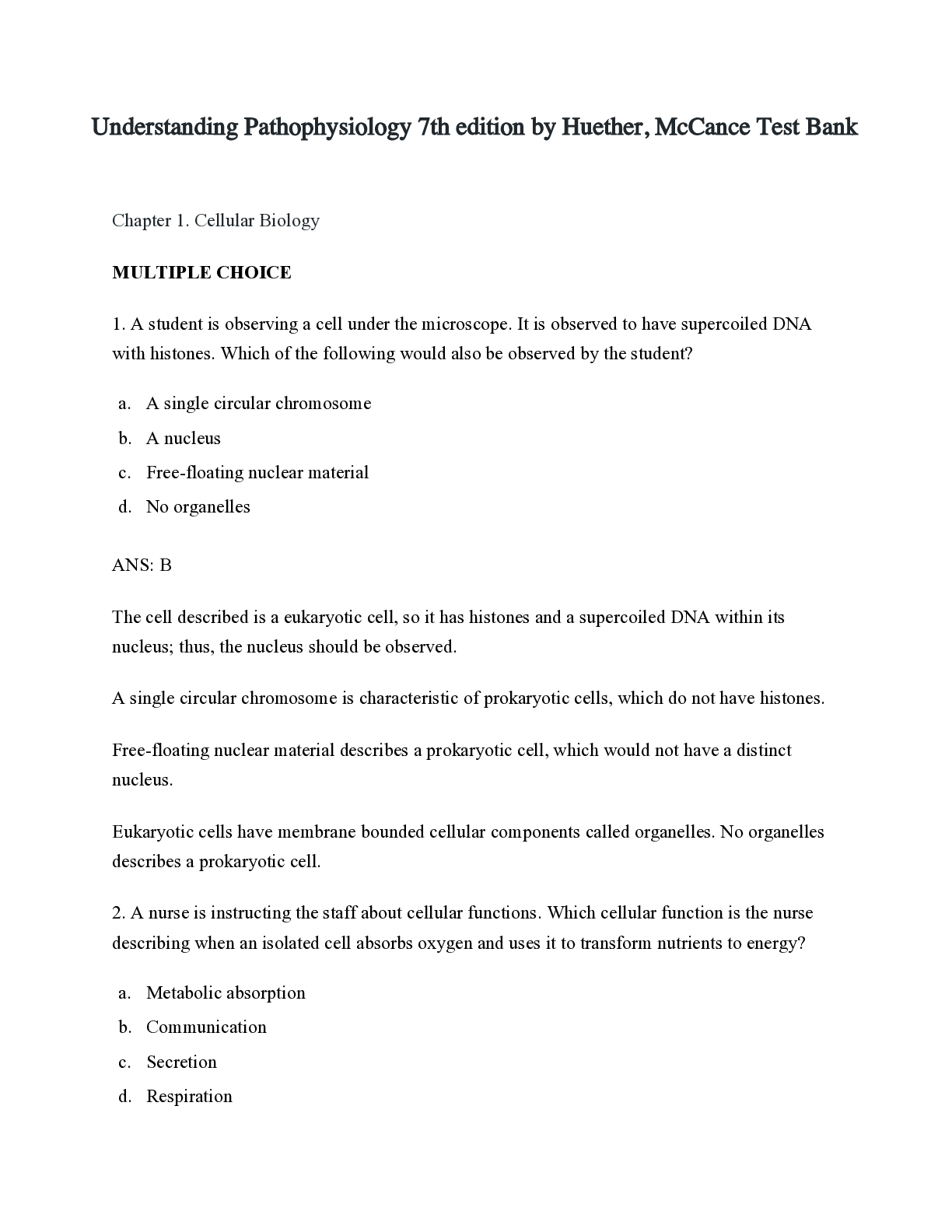
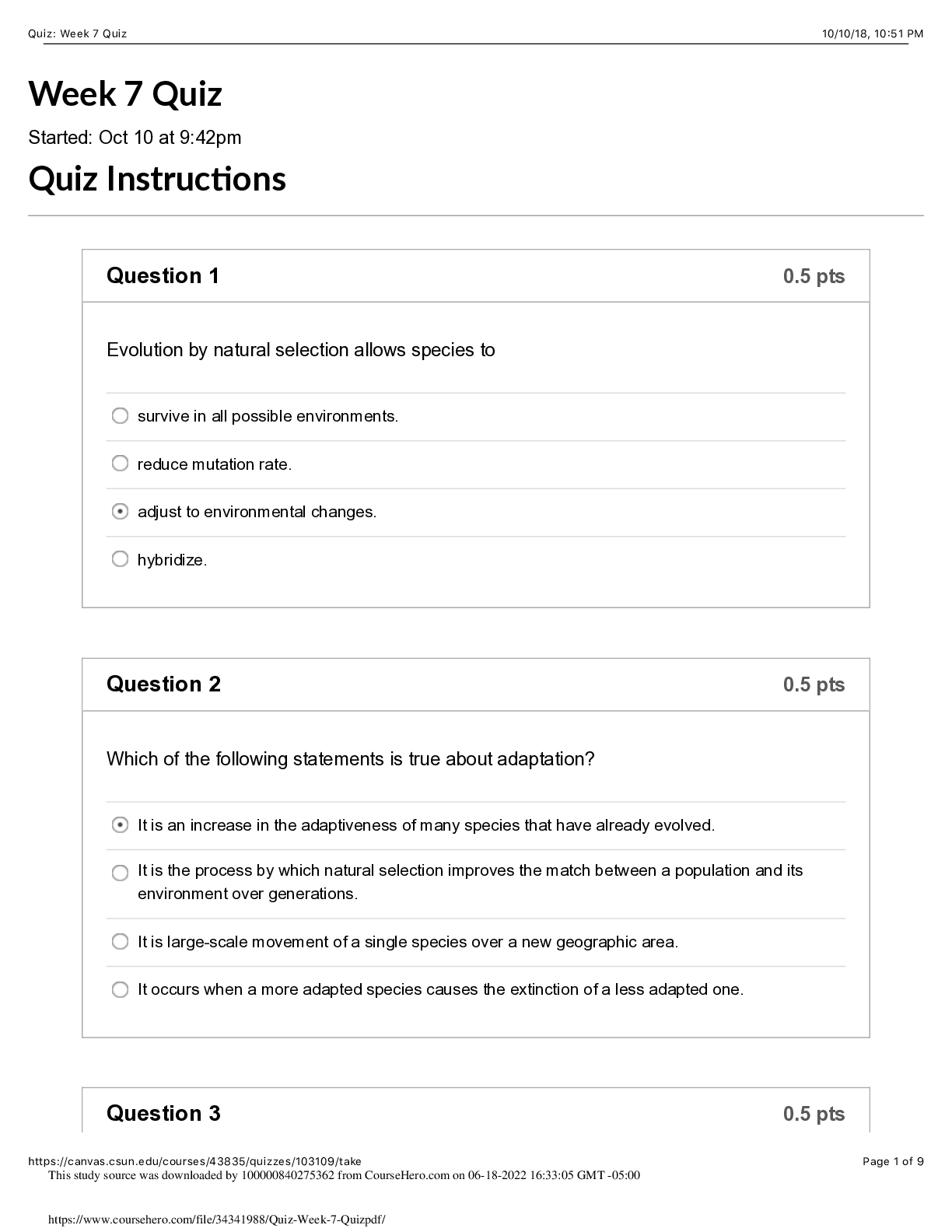
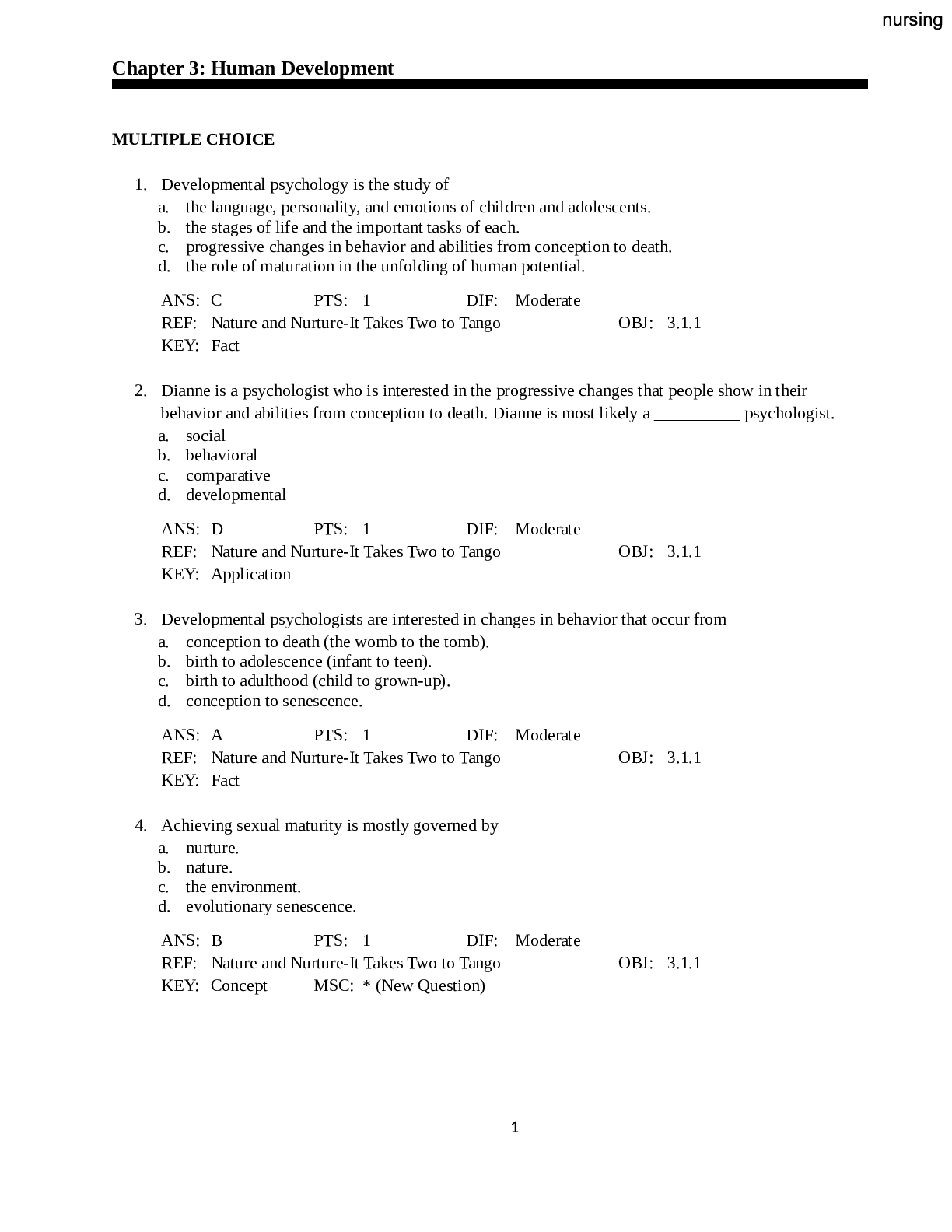
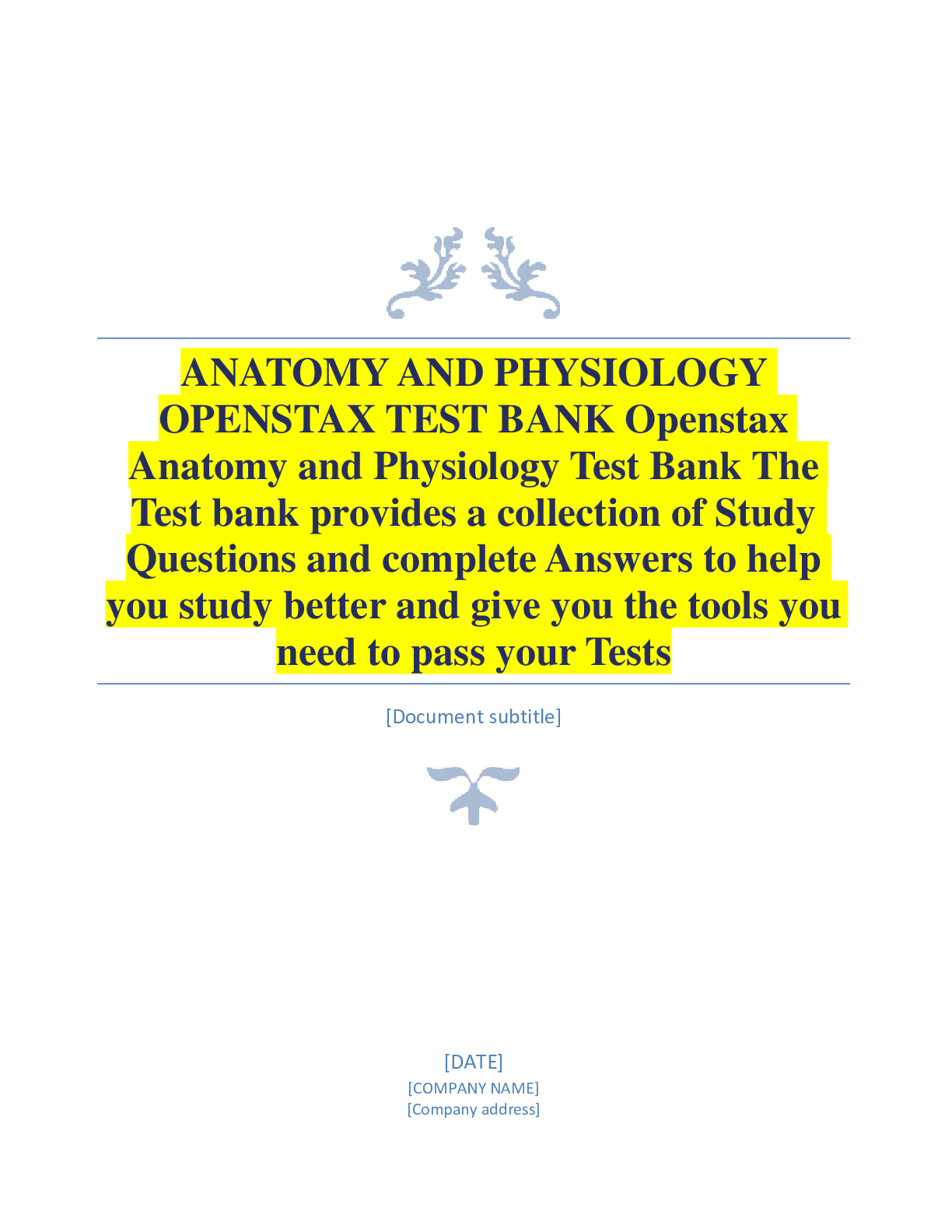
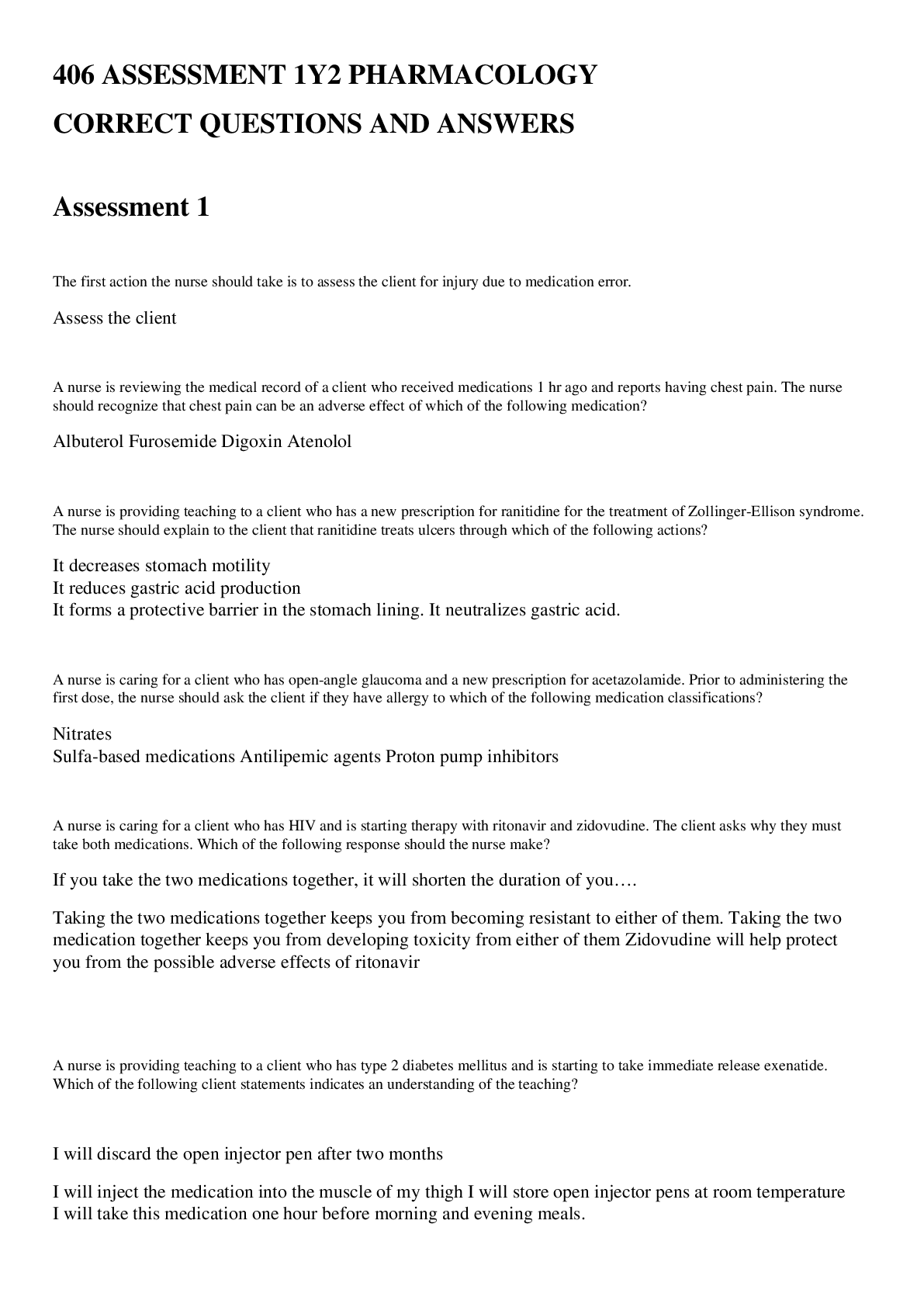
.png)
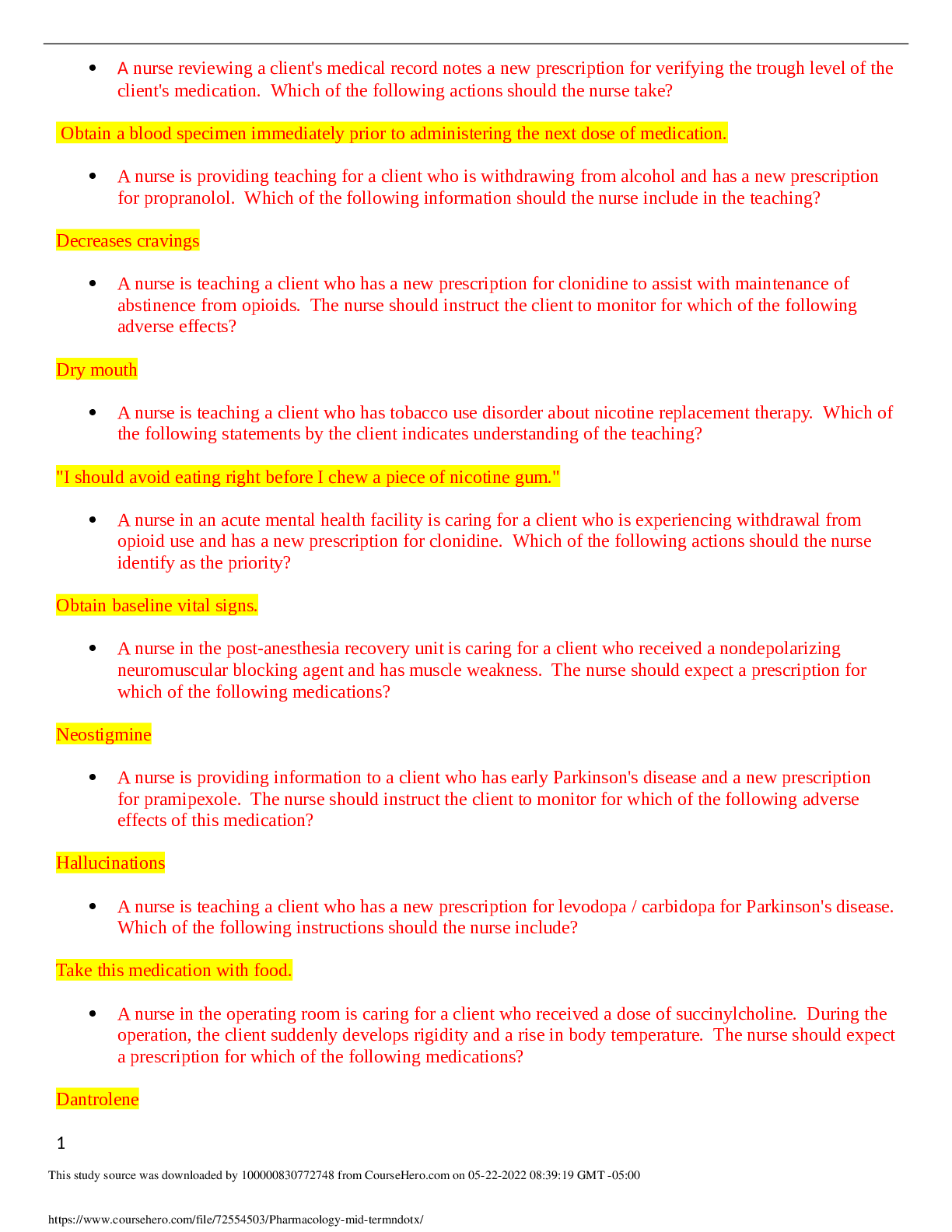
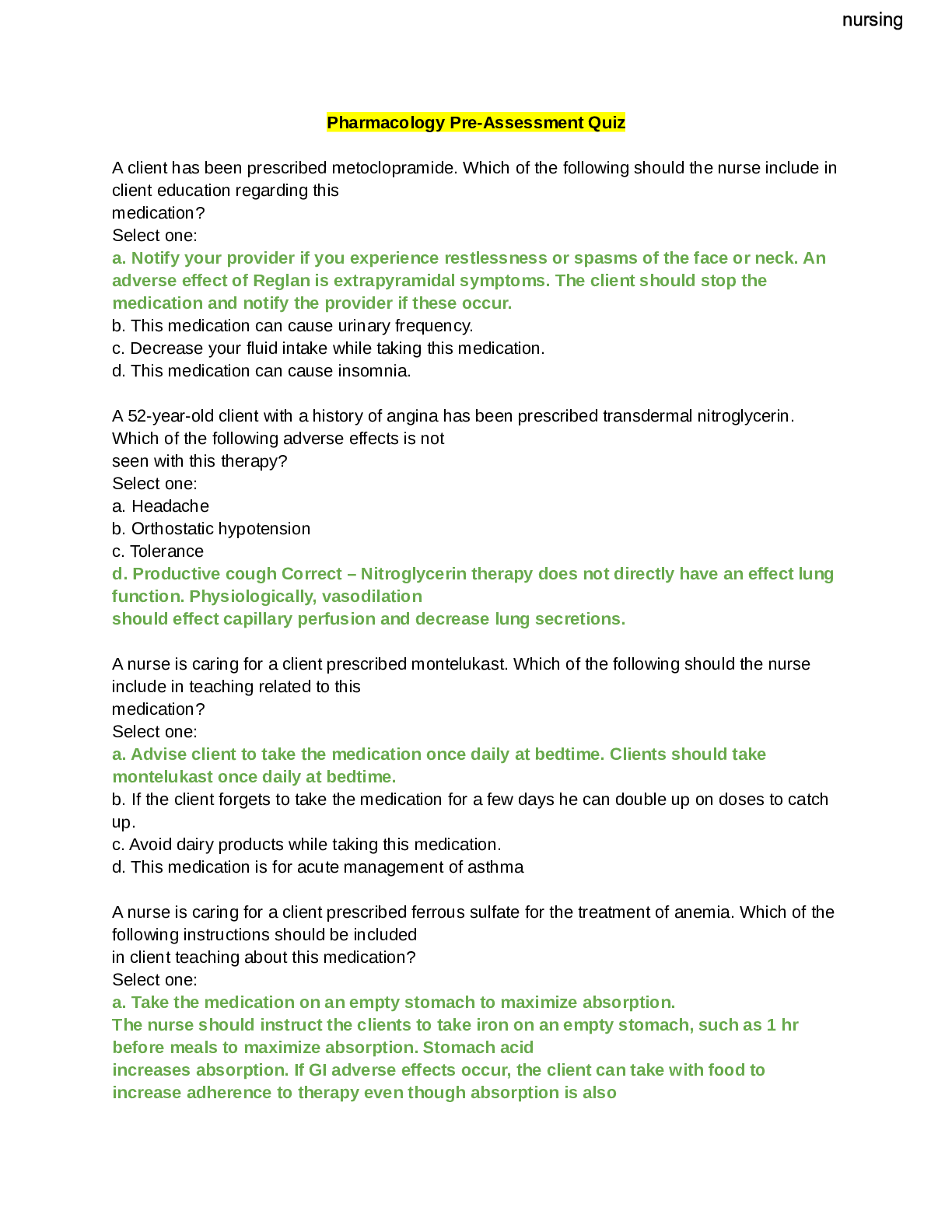
.png)
, All Correct, Download to Score A.png)
